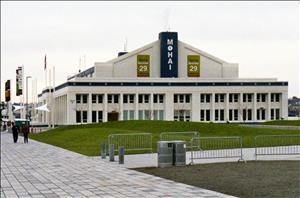On December 29, 2012, the Museum of History and Industry (MOHAI) reopens in its new South Lake Union location, 60 years after it first welcomed visitors in Seattle's Montlake neighborhood. Displaced from its Montlake home by highway construction, the museum is now located in the dramatic and historic Naval Reserve Building, constructed on the south shore of Lake Union at the start of World War II, during which it was a training site for new navy recruits. MOHAI's new home, which holds many important artifacts of Seattle's history, is a centerpiece of the city's recently developed Lake Union Park, located on 12 acres transferred by the navy to the city after the armory was closed.
Moving On
The Museum of History and Industry opened in Seattle's Montlake neighborhood in 1952, and was filled with artifacts, documents, and photographs collected by the Seattle Historical Society since the 1910s. When the Evergreen Point Floating Bridge opened in 1963, the museum became harder for members and visitors to access, and membership initially dropped off, although it grew again during the 1980s and beyond.
In the first years after the turn of the twenty-first century, when the state began looking into building a replacement span for the aging floating bridge, MOHAI's board of directors decided to search for a new museum site rather than suffer through any road construction in the Montlake area. MOHAI purchased property in downtown Seattle adjacent to the Washington State Convention and Trade Center, but museum officials soon set their sights on the South Lake Union neighborhood, which was just beginning to undergo a transformation.
Spurred on by investment from Paul Allen's Vulcan Real Estate Co. and others, South Lake Union was quickly becoming home to many growing businesses, including high-tech companies and biomedical research firms. New skyscrapers were on the way, but there was also a historic structure located on the shore of Lake Union that would be ideal for a museum -- the Naval Reserve Building. In 2005, the Seattle Parks & Recreation Department offered the building, commonly known as the armory, to MOHAI.
Naval Gazing
Designed by noted Seattle architect B. Marcus Priteca (1889-1971), the armory was built in 1941-1942. It opened soon after the United States entered World War II and was used to train thousands of young U.S. Navy recruits. After the war, the building was decommissioned but saw use as a Naval Reserve Center. In 1998, the navy disestablished the property, and two years later transferred ownership of the building to the City of Seattle.
The city leased out office space in the building and various community groups used the structure's grand open space to hold public gatherings and events. The city also began plans to develop Lake Union Park, a 12-acre park surrounding the armory. Meanwhile, MOHAI began eyeing the site and began a capital campaign to move into the building, which was added to the National Register of Historic Places in 2009.
The museum received $45 million from the state as compensation for the loss of the old Montlake building due to highway construction. Another $45 million was raised by MOHAI to renovate the armory, construct new exhibits, and transfer the museum's archives to a separate facility in Georgetown. In 2011, Amazon.com founder Jeff Bezos donated $10 million to establish a Center for Innovation within the museum walls.
Grand Opening
MOHAI's new facility opened to the public on December 29, 2012, when MOHAI Executive Director Leonard Garfield welcomed nearly 20,000 people who came to celebrate the next chapter in the museum's history. The 50,000-square-foot armory building expanded the museum's exhibition space by almost 10,000 square feet, allowing museum-goers to see new exhibits alongside old stand-bys.
Familiar artifacts were on display, such as the red neon Rainier Beer "R" sign, a 1934 wood model of the ferry Kalakala, and the 1919 Boeing B-1 floatplane that once carried airmail to Canada. New exhibits included a 65-foot-high sculpture made from planks of the historic schooner Wawona, posters and memorabilia from Seattle's grunge rock scene, and a life-size figure of a Japanese dancer that had been held in storage since 1954.
But the highlight of the museum was the building itself. Restored to its former glory, but repurposed for new use, the old armory building soon became a magnet for tourists and locals alike. Outside the museum, seven historic vessels were moored along the waterfront, including the tug Arthur Foss, the fireboat Duwamish, and the venerable Virginia V -- the last remnant of Puget Sound's mosquito fleet.

